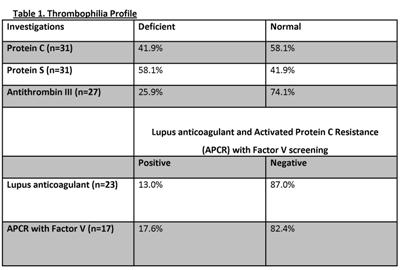
Contributions
Abstract: PB2220
Type: Publication Only
Background
Aims
We aimed at studying the disease variables of VTE in young healthy males of Indian origin and compare the same with other Indian studies as well as the global statistics.
Methods
Hospital records of 176 Color Doppler Flow Index (CDFI) and /or Contrast Enhanced Computed Tomography (CECT) proven VTE patients being followed up in a tertiary care hospital was analyzed retrospectively to document cause (provoked/ unprovoked), venous systems involved, thrombophilia profile, duration of anti-coagulation and recurrence.
Results
Among the study population, 49.8% had a provoked VTE. 90.9% subjects had DVT, mostly of the lower limb, 15.3% had PE with DVT, 2.8 % had PE alone and 6.2% had splanchninc vein thrombosis including portal vein thrombosis. In the subjects who had undergone thrombophilia profile, 41.9% had Protein C, 58.1% Protein S and 25.9% Antithrombin III deficiency. Lupus anticoagulant screen was positive for 13% of the screened subjects. The average duration of anti-coagulation was 18 months with majority (98.2%) patients on Vitamin K antagonist. The recurrence rate in our study population was found to be 11.4%.

Conclusion
Young Indian males have different disease variables for VTE as compared to western population. The exact pathophysiology of such differences needs to be studied further to formulate strategies for effective screening and prevention.
Session topic: 34. Thrombosis and vascular biology
Keyword(s): Pulmonary embolism, DVT
Abstract: PB2220
Type: Publication Only
Background
Aims
We aimed at studying the disease variables of VTE in young healthy males of Indian origin and compare the same with other Indian studies as well as the global statistics.
Methods
Hospital records of 176 Color Doppler Flow Index (CDFI) and /or Contrast Enhanced Computed Tomography (CECT) proven VTE patients being followed up in a tertiary care hospital was analyzed retrospectively to document cause (provoked/ unprovoked), venous systems involved, thrombophilia profile, duration of anti-coagulation and recurrence.
Results
Among the study population, 49.8% had a provoked VTE. 90.9% subjects had DVT, mostly of the lower limb, 15.3% had PE with DVT, 2.8 % had PE alone and 6.2% had splanchninc vein thrombosis including portal vein thrombosis. In the subjects who had undergone thrombophilia profile, 41.9% had Protein C, 58.1% Protein S and 25.9% Antithrombin III deficiency. Lupus anticoagulant screen was positive for 13% of the screened subjects. The average duration of anti-coagulation was 18 months with majority (98.2%) patients on Vitamin K antagonist. The recurrence rate in our study population was found to be 11.4%.

Conclusion
Young Indian males have different disease variables for VTE as compared to western population. The exact pathophysiology of such differences needs to be studied further to formulate strategies for effective screening and prevention.
Session topic: 34. Thrombosis and vascular biology
Keyword(s): Pulmonary embolism, DVT


